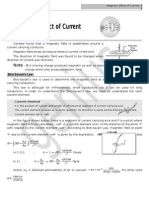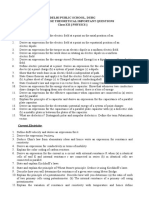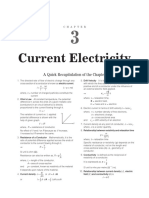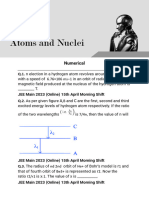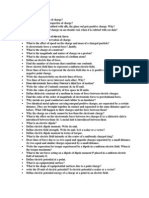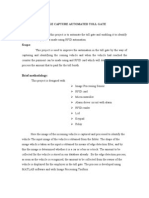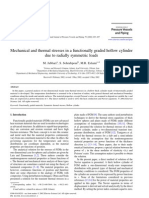2 D Motion
2 D Motion
Uploaded by
music_is_mypassionCopyright:
Available Formats
2 D Motion
2 D Motion
Uploaded by
music_is_mypassionOriginal Description:
Original Title
Copyright
Available Formats
Share this document
Did you find this document useful?
Is this content inappropriate?
Copyright:
Available Formats
2 D Motion
2 D Motion
Uploaded by
music_is_mypassionCopyright:
Available Formats
genius
PHYSICS
by Pradeep Kshetrapal
Motion in Two Dimension 1
The motion of an object is called two dimensional, if two of the three co-ordinates are
required to specify the position of the object in space changes w.r.t time.
In such a motion, the object moves in a plane. For example, a billiard ball moving over the
billiard table, an insect crawling over the floor of a room, earth revolving around the sun etc.
Two special cases of motion in two dimension are
motion
1. Projectile motion
2. Circular
PROJECTILE MOTION
3.1 Introduction.
A hunter aims his gun and fires a bullet directly towards a monkey sitting on a distant tree. If
the monkey remains in his position, he will be safe but at the instant the bullet leaves the barrel
of gun, if the monkey drops from the tree, the bullet will hit the monkey because the bullet will
not follow the linear path.
The path of motion of a bullet will be parabolic and this motion of bullet is defined as
projectile motion.
If the force acting on a particle is oblique with initial velocity then the motion of particle is called
projectile motion.
3.2 Projectile.
A body which is in flight through the atmosphere but is not being propelled by any fuel is
called projectile.
Example:
(i) A bomb released from an aeroplane in level flight
(ii) A bullet fired from a gun
(iii) An arrow released from bow
(iv) A Javelin thrown by an athlete
3.3 Assumptions of Projectile Motion.
(1) There is no resistance due to air.
(2) The effect due to curvature of earth is negligible.
genius
PHYSICS
by Pradeep Kshetrapal
2 Motion in Two Dimension
(3) The effect due to rotation of earth is negligible.
(4) For all points of the trajectory, the acceleration due to gravity g is constant in
magnitude and direction.
3.4 Principles of Physical Independence of Motions.
(1) The motion of a projectile is a two-dimensional motion. So, it can be discussed in two
parts. Horizontal motion and vertical motion. These two motions take place independent of each
other. This is called the principle of physical independence of motions.
(2) The velocity of the particle can be resolved into two mutually perpendicular components.
Horizontal component and vertical component.
(3) The horizontal component remains unchanged throughout the flight. The force of gravity
continuously affects the vertical component.
(4) The horizontal motion is a uniform motion and the vertical motion is a uniformly accelerated
retarded motion.
3.5 Types of Projectile Motion.
(1) Oblique projectile motion
an inclined plane
(2) Horizontal projectile motion
X
(3) Projectile motion on
Y
X
X
Y
3.6 Oblique Projectile.
In projectile motion, horizontal component of velocity (u cos), acceleration (g) and
mechanical energy remains constant while, speed, velocity, vertical component of velocity (u sin
), momentum, kinetic energy and potential energy all changes. Velocity, and KE are maximum
at the point of projection while minimum (but not zero) at highest point.
(1) Equation of trajectory : A projectile thrown with velocity u at an angle with the
horizontal. The velocity u can be resolved into two rectangular components.
Y
v cos component along Xaxis and u sin component along Yaxis.
For horizontal motion
x = u cos t t u cos . (i)
y (u sin ) t
For vertical motion
1 2
gt
2
x
u
cos
y x tan
1
x2
g 2
2 u cos2
O u cos
u sin
. (ii)
From equation (i) and (ii) y u sin
1
gx2
2 u2 cos2
This equation shows that the trajectory of projectile is parabolic because it is similar to
equation of parabola
y = ax bx2
Note
Equation of oblique projectile also can be written as
genius
PHYSICS
by Pradeep Kshetrapal
Motion in Two Dimension 3
y x tan 1
R
u2 sin2
)
g
(where R = horizontal range =
Sample problems based on trajectory
Problem 1. The trajectory of a projectile is represented by
(a) 30o
Solution : (c) By
(b) 45o
comparing
y x tan
tan
the
3x gx2 /2 . The angle of projection is
(c) 60o
coefficient
of
in
given
(d) None of these
equation
with
standard
equation
gx
2
2u cos2
3 60
Problem 2. The path followed by a body projected along y-axis is given as by
3x (1 / 2)x 2 , if g =
10 m/s, then the initial velocity of projectile will be (x and y are in m)
(a)
3 10 m/s
Solution : (b) By
comparing
y x tan
(b)
the
(c)
2 10 m/s
coefficient
of
x2
in
(d)
10 3 m/s
given
equation
with
10 2 m/s
standard
equation
gx
.
2u cos2
g
1
2
2
2
2u cos
Substituting = 60o we get
2
u 2 10 m / sec.
2
Problem 3. The equation of projectile is y 16x 5x . The horizontal range is
4
(a) 16 m
(b) 8 m
(c) 3.2 m
(d) 12.8 m
Solution : (d) Standard equation of projectile motion y x tan 1
R
Given equation : y 16x
5x 2
or y 16x 1
64 / 5
By comparing above equations R
64
=12.8 m.
5
(2) Displacement of projectile (r) : Let the particle acquires a position P having the
coordinates (x, y) just after time t from the instant of projection. The corresponding position
vector of the particle at time t is r as shown in the figure.
r x
i yj
.(i)
The horizontal distance covered during time t is given as
x vx t x u cos t
.(ii)
The vertical velocity of the particle at time t is given as
vy (v0 )y gt,
.(iii)
Now the vertical displacement y is given as
y u sin t 1 / 2 gt2
.(iv)
P (x, y)
vy
vx
X
vi
Putting the values of x and y from equation (ii) and equation (iv) in equation (i) we obtain
the position vector at any time t as
genius
PHYSICS
by Pradeep Kshetrapal
4 Motion in Two Dimension
r (u cos ) ti (u sin ) t gt2 j
2
gt
2u
r ut 1
gtsin
u
and
r (u t cos )2 (u t sin ) 1 gt2
2
tan1(y / x)
utsin 1 / 2gt2
(u t cos )
tan1
or
2u sin gt
2u cos
tan1
Note
:
The angle of elevation of the highest point
of the projectile and the angle of projection are
related to each other as
tan
1
tan
2
Sample problems based on displacement
Problem 4. A body of mass 2 kg has an initial velocity of 3 m/s along OE and it is subjected to a force of
4 Newtons in OF direction perpendicular to OE. The distance of the body from O after 4
seconds will be
(a)
48 m
12 m
(b) 28 m
Solution : (c) Body moves horizontally with constant initial velocity 3
x ut 3 4 12m
and in perpendicular direction it moves under the effect of
constant force with zero initial velocity upto 4 seconds.
1 F 2
1 4 2
1
t
4 16m
y ut (a) t2 0
2 m
2 2
2
So its distance from O is given by d
x 2 y2
(c) 20 m
(d)
m/s upto 4 seconds
O
E
d
(12)2 (16)2
F
d 20m
Problem 5. A body starts from the origin with an acceleration of 6 m/s2 along the x-axis and 8 m/s2 along
the y-axis. Its distance from the origin after 4 seconds will be
[MP PMT 1999]
(a)
128 m
56 m
(b) 64 m
Solution : (c) Displacement along X- axis : x ux t
Displacement along Y- axis : y uy t
Total distance from the origin
(c) 80 m
(d)
1
1
ax t 2 6 (4)2 48m
2
2
1
1
ay t 2 8 (4)2 64m
2
2
x 2 y2
(48)2 (64)2 80m
(3) Instantaneous velocity v : In projectile motion, vertical component of velocity changes
but horizontal component of velocity remains always constant.
Example : When a man jumps over the hurdle leaving behind its skateboard then vertical
component of his velocity is changing, but not the horizontal component, which matches with the
skateboard velocity.
As a result, the skateboard stays underneath him, allowing him to land on it.
genius
PHYSICS
by Pradeep Kshetrapal
Motion in Two Dimension 5
Let vi be the instantaneous velocity of projectile at time t direction of this velocity is along
the tangent to the trajectory at point P.
vx
u cos
vi vx i vyj vi vx2 vy2
vi
u2 cos2 (u sin gt)2
u2 g2t2 2u gtsin
Direction of instantaneous velocity tan
vy
vx
u sin gt
or
u cos
gt
tan1 tan sec
u
(4) Change in velocity : Initial velocity (at projection point) ui u cos i u sin j
Final velocity (at highest point) u f u cos i 0 j
(i) Change in velocity (Between projection point and highest point) u u f ui u sin j
When body reaches
u f u cos
i u sin j
the
ground
after
completing
its
motion
then
final
velocity
(ii) Change in velocity (Between complete projectile motion) u uf ui 2u sin i
Sample problems based on velocity
Problem 6. In a projectile motion, velocity at maximum height is
[AIEEE 2002]
(a)
None of these
u cos
2
(b) u cos
(c)
u sin
2
(d)
Solution : (b) In a projectile motion at maximum height body possess only horizontal component of
velocity i.e. u cos.
Problem 7. A body is thrown at angle 30o to the horizontal with the velocity of 30 m/s. After 1 sec, its
velocity will be (in m/s) (g = 10 m/s2)
(a)
(b) 700 10
10 7
(c) 100 7
(d)
40
Solution : (a) From the formula of instantaneous velocity
v
(30)2 (10)2 12 2 30 10 1 sin30o
u2 g2 t 2 2u g t sin
10 7 m/ s
Problem 8. A projectile is fired at 30o to the horizontal. The vertical component of its velocity is 80 ms1.
Its time of flight is T. What will be the velocity of the projectile at t = T/2
(a)
40 ms1
80 ms1
(b) 80 3 ms1
(c) (80/
1
3 ) ms
(d)
genius
PHYSICS
by Pradeep Kshetrapal
6 Motion in Two Dimension
Solution : (b) At half of the time of flight, the position of the projectile will be at the highest point of the
parabola and at that position particle possess horizontal component of velocity only.
Given uvertical u sin 80 u
80
sin30o
160m / s
uhorizontal u cos 160 cos30o 80 3 m / s.
Problem 9. A particle is projected from point O with velocity u in a direction making an angle with
the horizontal. At any instant its position is at point P at right angles to the initial
direction of projection. Its velocity at point P is
90o
u tan
(a)
(b)
u cot
(c) u cosec
90o
u sin
In projectile motion horizontal component of velocity
remains constant throughout the motion
(d) u sec
Solution : (b) Horizontal velocity at point 'O' u cos
Horizontal velocity at point ' P ' v sin
v sin
90o
v sin u cos v u cot
O u cos
Problem 10. A particle P is projected with velocity u1 at an angle of 30o with the horizontal. Another
particle Q is thrown vertically upwards with velocity u2 from a point vertically below the
highest point of path of P. The necessary condition for the two particles to collide at the
highest point is
(a)
u1 u2
(b)
u1 2u2
(c) u1
u2
2
u1
u1 4u2
(d)
u2
30o
Solution : (b) Both particle collide at the highest point it means the vertical distance travelled by both the
particle will be equal, i.e. the vertical component of velocity of both particle will be equal
u1 sin30 u2
u1
u2 u1 2u2
2
Problem 11. Two seconds after projection a projectile is travelling in a direction inclined at 30 o to the
horizontal after one more sec, it is travelling horizontally, the magnitude and direction of its
velocity are
[RPET 1999]
(a) 2 20 m/sec,60o
(b) 20 3 m/sec,60o
6 40 m/sec,30o
(c)
40 6 m/sec,30
Solution : (b) Let in 2 sec body reaches upto point A and after one more sec upto pointvB.
Total time of ascent for a body is given 3 sec i.e. t
u sin 10 3 30
u sin
3
u
g
..(i)
Horizontal component of velocity remains always constant
ucos vcos30
..(ii)
For vertical upward motion between point O and A
Usingv u g t
v sin30o u sin g 2
v sin30o 30 20
As u sin
30
u cos
30
(d)
genius
PHYSICS
by Pradeep Kshetrapal
Motion in Two Dimension 7
v 20m / s.
Substituting this value in equation (ii)
u cos 20cos30o 10 3 ..(iii)
From equation (i) and (iii) u 20 3 and 60
Problem 12. A body is projected up a smooth inclined plane (length =
20 2 m )
with velocity u from the
point M as shown in the figure. The angle of inclination is 45 o and the top is connected to a
well of diameter 40 m. If the body just manages to cross the well, what is the value of v
(a) 40ms1
(b) 40 2 ms1
45o
(c) 20ms1
(d) 20 2 ms1
40 m
Solution : (d) At point N angle of projection of the body will be 45. Let velocity of projection at this point is
v.
of well
If the body just manages to cross the well then Range Diameter
v2 sin2
40
g
v2 400
As
45
v
N
R
v 20m / s
45o
But we have to calculate the velocity (u) of the body at point M.
u
For motion along the inclined plane (from M to N)
Final velocity (v) = 20 m/s,
40 m
acceleration (a) = g sin = g sin 45o, distance of inclined plane (s) = 20 2 m
(20)2 u2 2
g
2
.20 2
u2 202 400 u
[Using v2 = u2 + 2as]
20 2 m/ s.
Problem 13. A projectile is fired with velocity u making angle with the horizontal. What is the change in
velocity when it is at the highest point
u cos
(a)
(u cos u)
(c) u sin
(b) u
(d)
Solution : (c) Since horizontal component of velocity remain always constant therefore only vertical
component of velocity changes.
Initially vertical component u sin
Finally it becomes zero. So change in velocity u sin
(5) Change in momentum : Simply by the multiplication of mass in the above expression of
velocity (Article-4).
(i) Change in momentum (Between projection point and highest point)
p p f pi musin j
(ii) Change in momentum (For the complete projectile motion) p p f pi 2musin j
(6) Angular momentum : Angular momentum of projectile
Y at highest point of trajectory
about the point of projection is given by
L mvr
Herer H
u2 sin2
2g
P = mv
u
r
X
genius
PHYSICS
by Pradeep Kshetrapal
8 Motion in Two Dimension
L m u cos
m u3 cos sin2
u2 sin2
2g
2g
Sample problems based on momentum and angular momentum
Problem 14.
A body of mass 0.5 kg is projected under gravity with a speed of 98 m/s at an angle of 30o
with the horizontal. The change in momentum (in magnitude) of the body is
[MP PET 1997]
(a) 24.5 Ns
Solution : (b) Change
(b) 49.0 Ns
in
momentum
between
2 0.5 98 sin30 = 49 Ns.
(c) 98.0 Ns
complete
projectile
(d) 50.0 Ns
motion
2mu
sin
Problem 15. A particle of mass 100 g is fired with a velocity 20 m sec1 making an angle of 30o with the
horizontal. When it rises to the highest point of its path then the change in its momentum is
(a)
3kgmsec1
(b) 1/2 kg m sec1
(c)
2 kgmsec1
(d) 1 kg m sec1
Solution : (d) Horizontal momentum remains always constant
So change in vertical momentum ( p ) = Final vertical momentum Initial vertical
momentum 0 musin
| P | 0.1 20 sin30o 1kgm / sec.
Problem 16. Two equal masses (m) are projected at the same angle () from two points separated by
their range with equal velocities (v). The momentum at the point of their collision is
(a) Zero
(b) 2 mv cos
(c) 2 mv cos
(d) None of these
Solution : (a) Both masses will collide at the highest point of their trajectory with equal and opposite
momentum. So net momentum of the system will be zero.
mv cos mv cos
v
Problem 17. A particle of mass m is projected with velocity v making an angle of 45o with the horizontal.
The magnitude of the angular momentum of the particle about the point of projection when
the particle is at its maximum height is (where g = acceleration due to gravity)
[MP PMT 1994; UPSEAT 2000; MP PET 2001]
(a) Zero
Solution : (b) L
(b) mv3/ (4 2g)
mv3
m u3 cos sin2
=
2g
(4 2 g)
(c) mv3/ ( 2g)
(d) mv2/2g
[As = 45o]
Problem 18. A body is projected from the ground with some angle to the horizontal. What happens to the
angular momentum about the initial position in this motion
[AIIMS 2000]
(a) Decreases
(b) Increases
(c) Remains same
(d) First increases and then decreases
Solution : (b)
Problem 19. In case of a projectile, where is the angular momentum minimum
(a) At the starting point
(b) At the highest point
(c) On return to the ground
(d) At some location other than those mentioned above
genius
PHYSICS
by Pradeep Kshetrapal
Motion in Two Dimension 9
Solution : (a)
(7) Time of flight : The total time taken by the projectile to go up and come down to the
same level from which it was projected is called time of flight.
For vertical upward motion 0 = u sin gt t = (u sin /g)
Now as time taken to go up is equal to the time taken to come down so
2u sin
Time of flight T 2t
g
(i) Time of flight can also be expressed as : T
2.uy
g
(where uy is the vertical component of
initial velocity).
(ii) For complementary angles of projection and 90o
(a) Ratio of time of flight =
T1
T1
2u sin / g
tan
= tan
T2 2u sin(90 ) / g
T2
(b) Multiplication of time of flight = T1T2
2u sin 2u cos
g
g
T1T2
2R
g
(iii) If t1 is the time taken by projectile to rise upto point p and t2 is the time taken in falling
from point p to ground level then t1 t2
u sin
or
g(t1 t2 )
2
and height of the point p is given by
h g
2u sin
time of flight
g
1
h u sin t1 gt12
2
(t1 t2 ) 1 2
t1 gt1
2
2
by solving h
g t1t2
2
(iv) If B and C are at the same level on trajectory and the time difference between these two
points is t1, similarly A and D are also at the same level and the time difference between these
two positions is t2 then
t22 t12
8h
g
B
A
t1
t2
C
D
Sample problems based on time of flight
Problem 20. For a given velocity, a projectile has the same range R for two angles of projection if t1 and t2
are the times of flight in the two cases then
[KCET 2003]
(a) t1t 2 R 2
(b) t1t 2 R
(c) t1t 2
1
R
(d) t1t 2
1
R2
genius
PHYSICS
by Pradeep Kshetrapal
10 Motion in Two Dimension
Solution : (b) As we know for complementary angles t1t2
2R
t1t2 R .
g
Problem 21. A body is thrown with a velocity of 9.8 m/s making an angle of 30o with the horizontal. It will
hit the ground after a time
[JIPMER 2001, 2002; KCET (Engg.) 2001]
(a) 1.5 s
Solution : (b) T
(b) 1 s
(c) 3 s
(d) 2 s
2u sin
2 9.8 sin30o
= 1sec
g
9.8
Problem 22. Two particles are separated at a horizontal distance x as shown in figure. They are projected
at the same time as shown in figure with different initial speed. The time after which the
horizontal distance between the particles become zero is
[CBSE PMT 1999]
u
u/ 3
60o
30o
A
(a) u /2x
(b) x/u
(c) 2u/x
(d) u/x
Solution : (b) Let x1 and x2 are the horizontal distances travelled by particle A and B respectively in time
t.
x1
u
3
x1 x2
. cos30 t
u
3
..(i)
x2 u cos60o t
and
. cos30o t u cos60o t ut
x ut
(ii)
t x /u
Problem 23. A particle is projected from a point O with a velocity u in a direction making an angle
upward with the horizontal. After some time at point P it is moving at right angle with its
initial direction of projection. The time of flight from O to P is
(a)
u sin
g
(b)
u cosec
(c)
u tan
g
(d)
Solution : (b) When body projected with initial velocity u by making angle
time t, (at point P) its direction is perpendicular to u .
u sec
g
with the horizontal. Then after
Magnitude of velocity at point P is given by v u cot . (from sample problem no. 9)
Final velocity (at point P) vcos u cot cos
Time of flight (from point O to P) = t
u sin
For vertical motion : Initial velocity (at point O) u sin
Applying first equation of motion v u g t
O
u cot cos u sin g t
90o
u cos
v cos
(90 )
v
u sin u cot cos
u cosec
sin2 cos2
g
g sin
g
Problem 24. A ball is projected upwards from the top of tower with a velocity 50 ms 1 making angle 30o
with the horizontal. The height of the tower is 70 m. After how many seconds from the
instant of throwing will the ball reach the ground
(a) 2.33 sec
(b) 5.33 sec
(c) 6.33 sec
(d) 9.33 sec
genius
PHYSICS
by Pradeep Kshetrapal
Motion in Two Dimension 11
Solution : (c) Formula for calculation of time to reach the body on the ground from the tower of height h
(If it is thrown vertically up with velocity u) is given by
u
u
u
2gh
sin30o
t 1 1 2
30o
g
u
So we can resolve the given velocity in vertical direction
and can apply the above formula.
70 m
Initial vertical component of velocity u sin 50sin30
25m/ s.
25
2 9.8 70
1 1
9.8
(25)2
= 6.33 sec.
Problem 25. If for a given angle of projection, the horizontal range is doubled, the time of flight becomes
(a) 4 times
Solution : (c)
(b) 2 times
(c)
2 times
(d) 1 / 2 times
2u sin
u2 sin2
and T
g
g
R u2 and
T u (If and g are constant).
In the given condition to make range double, velocity must be increased upto
of previous value. So automatically time of flight will becomes 2 times.
2 times that
Problem 26. A particle is thrown with velocity u at an angle from the horizontal. Another particle is
thrown with the same velocity at an angle from the vertical. The ratio of times of flight of
two particles will be
(a) tan 2 : 1
(b) cot 2 : 1
(c) tan : 1
(d) cot : 1
Solution : (c) For first particles angle of projection from the horizontal is . So T1
2u sin
g
For second particle angle of projection from the vertical is . it mean from the horizontal is
(90 ).
T2
T1
2u cos
2u sin(90 )
tan .
. So ratio of time of flight
g
g
T2
Problem 27. The friction of the air causes vertical retardation equal to one tenth of the acceleration due
to gravity (Take g = 10 ms2). The time of flight will be decreased by
(a) 0%
(b) 1%
(c) 9%
(d) 11%
Solution : (c)
g
2u sin
T
g
10 11
1 2
g
T2
g1
10
Fractional decrease in time of flight
T1 T2
1
T1
11
Percentage decrease = 9%
u
(8) Horizontal range : It is the horizontal distance travelled by a body during the time of
flight.
So by using second equation of motion
u2 sin2
R u cos T u cos (2u sin / g)
g
Horizontal range
genius
PHYSICS
by Pradeep Kshetrapal
12 Motion in Two Dimension
u2 sin2
g
(i) Range of projectile can also be expressed as :
R = u cos T = u cos
R
2uxuy
g
2uxuy
2u cos u sin
2u sin
g
g
g
(where ux and uy are the horizontal and vertical component of initial
velocity)
(ii) If angle of projection is changed from to = (90 ) then range remains unchanged.
60o
30o
R'
Blast
u2 sin2 '
u2 sin[2(90o )] u2 sin2
R
g
g
g
So a projectile has same range at angles of projection and (90 ), though time of flight,
maximum height and trajectories are different.
These angles and 90o are called complementary angles of projection and for
R1
R
u2 sin2 / g
1
1
complementary angles of projection ratio of range 1 2
R2
R2 u sin[2(90o )]/ g
(iii) For angle of projection 1 = (45 ) and 2 = (45 + ), range will be same and equal to
u2 cos 2/g.
1 and 2 are also the complementary angles.
(iv) Maximum range : For range to be maximum
dR
d u2 sin2
0
0
d
g
d
cos 2 = 0 i.e. 2 = 90o = 45o and Rmax = (u2/g)
45o
Rmax = 4 H
i.e., a projectile will have maximum range when it is projected at an angle of 45 o to the
horizontal and the maximum range will be (u2/g).
When the range is maximum, the height H reached by the projectile
H
u2 sin2 u2 sin2 45 u2 Rmax
2g
2g
4g
4
i.e., if a person can throw a projectile to a maximum distance Rmax, The maximum height to which it
Rmax
.
will rise is
4
(v) Relation between horizontal range and maximum height : R
u2 sin2
u2 sin2
and H
g
2g
genius
PHYSICS
by Pradeep Kshetrapal
Motion in Two Dimension 13
R
u2 sin2 / g
2
4 cot
H u sin2 / 2g
R 4H cot
(vi) If in case of projectile motion range R is n times the maximum height H
i.e.
R = nH
u2 sin2
u2 sin2
n
tan [4 / n] or tan1[4 / n]
g
2g
The angle of projection is given by tan1[4 / n]
Note
If R = H then tan1(4) or 76o .
If R = 4H then tan1(1) or 45o .
Sample problem based on horizontal range
Problem 28.
A boy playing on the roof of a 10m high building throws a ball with a speed of 10 m/s at
an angle of 30o with the horizontal. How far from the throwing point will the ball be at the
1
3
height of 10 m from the ground (g = 10 m/s2, sin 30o =
, cos 30o
)
2
2
[AIEEE 2003]
(a) 8.66 m
(b) 5.20 m
(c) 4.33 m
(d) 2.60 m
Solution : (a) Simply we have to calculate the range of projectile
u2 sin2
(10)2 sin(2 30)
R
g
10
30o
10
m
R 5 3 8.66meter
Problem 29.
10
m
Which of the following sets of factors will affect the horizontal distance covered by an
athlete in a longjump event
[AMU (Engg.) 2001]
(a) Speed before he jumps and his weight
(b) The direction in which he leaps and the initial speed
(c) The force with which he pushes the ground and his speed
(d) The direction in which he leaps and the weight
Solution : (b) Because range
(Velocityof projection
)2 sin2(Angleof project
ion)
g
Problem 30. For a projectile, the ratio of maximum height reached to the square of flight time is ( g = 10
ms2)
[EAMCET (Med.) 2000]
(a) 5 : 4
Solution : (a) H
(b) 5 : 2
2u sin
u2 sin2
and T
g
2g
(c) 5 : 1
H
T
(d) 10 : 1
u2 sin2 / 2g
g 10 5
4 u2 sin2 / g2
8
8
4
Problem 31. A cricketer can throw a ball to a maximum horizontal distance of 100 m. The speed with
which he throws the ball is (to the nearest integer)
[Kerala (Med.) 2002]
(a) 30 ms
Solution : (c)
Rmax
u2
= 100
g
(b) 42 ms1
(when 45 )
(c) 32 ms1
(d) 35 ms1
genius
PHYSICS
by Pradeep Kshetrapal
14 Motion in Two Dimension
1000 31.62m/ s.
Problem 32. If two bodies are projected at 30o and 60o respectively, with the same velocity, then
[CBSE PMT
2000; JIPMER 2002]
(a) Their ranges are same
same
(b)
(c) Their times of flight are same
Their
heights
are
(d) All of these
Solution : (a) Because these are complementary angles.
Problem 33. Figure shows four paths for a kicked football. Ignoring the effects of air on the flight, rank
the paths according to initial horizontal velocity component, highest first
[AMU (Med.) 2000]
(a) 1, 2, 3, 4
(b) 2, 3, 4, 1
(c) 3, 4, 1, 2
(d) 4, 3, 2, 1
Solution : (d) Range horizontal component of velocity. Graph 4 shows maximum range, so football
possess maximum horizontal velocity in this case.
Problem 34. Four bodies P, Q, R and S are projected with equal velocities having angles of projection 15 o,
30o, 45o and 60o with the horizontal respectively. The body having shortest range is
[EAMCET (Engg.) 2000]
(a) P
(b) Q
(c) R
(d) S
Solution : (a) Range of projectile will be minimum for that angle which is farthest from 45.
Problem 35. A particle covers 50 m distance when projected with an initial speed. On the same surface it
will cover a distance, when projected with double the initial speed
[RPMT 2000]
(a) 100 m
Solution : (c)
(b) 150 m
R2 u2
u2 sin2
R u2 so
g
R1 u1
(c) 200 m
2
2u
(d) 250 m
R2 4R1 = 4 50 = 200 m
Problem 36. A bullet is fired from a canon with velocity 500 m/s. If the angle of projection is 15 o and g =
10 m/s2. Then the range is
[CPMT 1997]
3
(a) 25 10 m
Solution : (b) Range(R)
(b) 12.5 103 m
(c) 50 102 m
(d) 25 102 m
u2 sin2
500 2 sin 2 15 12500m 12.5 103 m
g
10
Problem 37. A projectile thrown with a speed v at an angle has a range R on the surface of earth. For
same v and , its range on the surface of moon will be
(a) R/6
Solution : (b) R
(b) 6 R
u2 sin2
g
R Moon gEarth
=6
R Earth gMoon
R 1/ g
gMoon 6 gEarth
RMoon 6 R Earth 6R
(c) R/36
(d) 36 R
genius
PHYSICS
by Pradeep Kshetrapal
Motion in Two Dimension 15
Problem 38. A projectile is thrown into space so as to have maximum horizontal range R. Taking the point
of projection as origin, the co-ordinates of the point where the speed of the particle is
minimum are
(b) R,
(a) (R, R)
R R
,
2 4
Solution : (c) For maximum horizontal Range 45
From R 4H cot = 4H
range.]
(c)
(d) R,
[As = 45o, for maximum
Speed of the particle will be minimum at the highest
point of parabola.
R/4
45o
R/2
So the co-ordinate of the highest point will be (R/2,
R/4)
Problem 39. The speed of a projectile at the highest point becomes
times its initial speed. The
horizontal range of the projectile will be
(a)
u2
g
u2
2g
(b)
Solution : (a) Velocity at the highest point is given by u cos
Horizontal range R
u2
3g
(c)
u
2
(d)
(given)
u2
4g
= 45o
u2 sin2
u2 sin(2 45o ) u2
g
g
g
Problem 40. A large number of bullets are fired in all directions with same speed u. What is the maximum
area on the ground on which these bullets will spread
(a)
u2
g
(b)
u4
g
2
(c)
u4
g
2
(d)
u2
g2
Solution : (b) The maximum area will be equal to area of the circle with radius equal to the maximum
range of projectile
u2
Maximum area r 2 Rmax 2
g
= 45o]
Problem 41. A projectile is projected with initial velocity
u4
[As r Rmax u2 / g for
(6
i 8j)m / sec. If g = 10 ms2, then horizontal
range is
(a) 4.8 metre
(b) 9.6 metre
(c) 19.2 metre
(d) 14.0 metre
Solution : (b) Initial velocity 6
i 8J m/ s (given)
Magnitude of velocity of projection u ux2 uy2 62 8 2 = 10 m/s
Angle of projection tan
uy
ux
8
4
3
4
sin and cos
6
5
5
3
(10) 2
u2 sin2
u2 2sin cos
Now horizontal range R
5 5 9.6 meter
g
g
10
genius
PHYSICS
by Pradeep Kshetrapal
16 Motion in Two Dimension
Problem 42. A projectile thrown with an initial speed u and angle of projection 15o to the horizontal has a
range R. If the same projectile is thrown at an angle of 45 o to the horizontal with speed 2u,
its range will be
(a) 12 R
Solution : (c)
(b) 3 R
(c) 8 R
(d) 4 R
u sin2
R u2 sin2
g
R2 u2
R1 u1
o
sin2 2
2u sin90
R2 R1
u sin30o
sin2 1
8R1
Problem 43. The velocity at the maximum height of a projectile is half of its initial velocity of projection u.
Its range on the horizontal plane is
[MP PET 1993]
(a)
(c) 3u2 / 2g
(b) u2 / 3g
3u / 2g
(d) 3u2 / g
Solution : (a) If the velocity of projection is u then at the highest point body posses only u cos
u cos
u
(given)
2
Now R
u2 sin(2 60)
3 u2
2 g
g
60
Problem 44. A projectile is thrown from a point in a horizontal place such that its horizontal and vertical
velocity component are 9.8 m/s and 19.6 m/s respectively. Its horizontal range is
(a) 4.9 m
(b) 9.8 m
Solution : (d) We know R
2ux uy
g
(c) 19.6 m
(d) 39.2 m
2 9.8 19.6
39.2 m
9.8
Where ux horizontal component of initial velocity, uy vertical component of initial
velocity.
Problem 45. A particle is projected with a velocity v such that its range on the horizontal plane is twice
the greatest height attained by it. The range of the projectile is (where g is acceleration due
to gravity)
[BHU 1984]
(a)
4v2
5g
(b)
4g
(c)
5v
v2
g
(d)
4v2
5g
Solution : (a) We know R 4H cot
1 sin 2 cos 1
;
;
5
5
2
2
1
2u2
.
u2 . 2. sin . cos
4u2
Range
5
5
g
5g
g
2H 4H cot
As R 2H given
cot
Problem 46. The range R of projectile is same when its maximum heights are h1 and h2. What is the
relation between R and h1 and h2
[EAMCET (Med.) 2000]
(a) R
h1h2
(b) R
2h1h2
(c) R 2 h1h2
(d) R 4 h1h2
Solution : (d) For equal ranges body should be projected with angle or (90o ) from the horizontal.
And for these angles : h1
u2 sin2
u2 cos2
and h2
2g
2g
by multiplication of both height : h1 h2
u2 sin2 cos2
4g 2
1 u2 sin2
16
g
genius
PHYSICS
by Pradeep Kshetrapal
Motion in Two Dimension 17
2
16h1 h2 R R 4 h1h2
Problem 47. A grasshopper can jump maximum distance 1.6 m. It spends negligible time on the ground.
How far can it go in 10 seconds
(a)
(b)
2m
(c)
10 2 m
(d)
20 2 m
40 2 m
Solution : (c) Horizontal distance travelled by grasshopper will be maximum for 45
Rmax
u2
1.6 m
g
u 4 m / s.
Horizontal component of velocity of grasshopper u cos 4 cos45
Total distance covered by it in10 sec. S u cos t
Problem 48. A projectile is thrown with an initial velocity of
2 2 m/ s
2 2 10 20 2 m
1.6 m
v a
i bj, if the range of projectile is
double the maximum height reached by it then
(a) a = 2b
(b) b = a
1
Solution : (c) Angle of projection tan
vy
vx
tan1
(c) b = 2a
b
a
From formula R 4H cot 2H cot
From equation (i) and (ii)
tan
(d) b = 4a
b
a
(i)
1
tan 2
2
(ii)
[As R = 2H given]
b = 2a
(9) Maximum height : It is the maximum height from the point of projection, a projectile
can reach.
So, by using v2 u2 2as
u2 sin2
2g
(i) Maximum height can also be expressed as
H
(ii) H max
uy2
2g
Max.
height
0 (u sin )2 2gH
u
(where uy is the vertical component of initial velocity).
u2
2g
(when sin2 = max = 1 i.e., = 90o)
i.e., for maximum height body should be projected vertically upward. So it falls back to the
point of projection after reaching the maximum height.
(iii) For complementary angles of projection and 90o
H1
u2 sin2 / 2g
sin2
Ratio of maximum height =
tan2
2
2
o
H 2 u sin (90 )2g
cos2
H1
tan2
H2
Sample problem based on maximum height
genius
PHYSICS
by Pradeep Kshetrapal
18 Motion in Two Dimension
Problem 49. A cricketer can throw a ball to a maximum horizontal distance of 100 m. With the same
effort, he throws the ball vertically upwards. The maximum height attained by the ball is
[UPSEAT 2002]
(a) 100 m
(b) 80 m
(c) 60 m
u2
100m
g
Solution : (d) Rmax
(d) 50 m
(when 45 )
u2 100 10 1000
H max
1000
u2
50metre
. (when 90 )
2g
2 10
Problem 50. A ball thrown by one player reaches the other in 2 sec. the maximum height attained by the
ball above the point of projection will be about
[Pb. PMT 2002]
(a) 10 m
Solution : (c)
(b) 7.5 m
2u sin
2 sec
g
Now
(c) 5 m
(d) 2.5 m
u sin 10
(given)
u2 sin2
(10)2
5 m.
2g
2 10
Problem 51. Two stones are projected with the same magnitude of velocity, but making different angles
with horizontal. The angle of projection of one is /3 and its maximum height is Y, the
maximum height attained by the other stone with as /6 angle of projection is
[J & K CET 2000]
(a) Y
(b) 2 Y
(c) 3 Y
(d)
Y
3
Solution : (d) When two stones are projected with same velocity then for complementary angles and
(90o )
Ratio of maximum heights :
H1
H
tan2 tan2 3 H 2 1 Y
H2
3
3
3
Problem 52. If the initial velocity of a projectile be doubled. Keeping the angle of projection same, the
maximum height reached by it will
(a) Remain the same
Solution : (c)
u2 sin2
2g
(b) Be doubled
H u2
(c) Be quadrupled
(d) Be halved
[As constant]
If initial velocity of a projectile be doubled then H will becomes 4 times.
Problem 53. Pankaj and Sudhir are playing with two different balls of masses m and 2m respectively. If
Pankaj throws his ball vertically up and Sudhir at an angle , both of them stay in our view
for the same period. The height attained by the two balls are in the ratio
(a) 2 : 1
(b) 1 : 1
(c) 1 : cos
(d) 1 : sec
2u1
g
u1
Solution : (b) Time of flight for the ball thrown by Pankaj T1
Time of flight for the ball thrown by Sudhir T2
According to problem T1 T2
90o
2u2 sin(90o ) 2u2 cos
g
g
2u1 2u2 cos
g
g
u2
2m
Short Trick :
u1 u2 cos
Maximum
height H T2
(As T1 = T2)
genius
PHYSICS
by Pradeep Kshetrapal
Motion in Two Dimension 19
Height of the ball thrown by Pankaj H 1
u12
2g
Height of the ball thrown by Sudhir H 2
u22 sin2 (90o ) u22 cos2
2g
2g
H1
u2 / 2g
2 12
=1
H 2 u2 cos / 2g
[As u1 u2 cos ]
Problem 54. A boy aims a gun at a bird from a point, at a horizontal distance of 100 m. If the gun can
impart a velocity of 500 ms1 to the bullet. At what height above the bird must he aim his
gun in order to hit it (take g = 10 ms2)
[CPMT 1996]
(a) 20 cm
(b) 10 cm
(c) 50 cm
(d) 100 cm
100 1
sec
500 5
In this time the bullet also moves downward due to gravity its vertical displacement
2
1
1
1
h g t2 10 1 / 5 m = 20 cm
2
2
5
Solution : (a) Time taken by bullet to travel a horizontal distance of 100 m is given by t
So bullet should be fired aiming 20 cm above the bird to hit it.
Problem 55. The maximum horizontal range of a projectile is 400 m. The maximum height attained by it
will be
(a) 100 m
Solution : (a)
(b) 200 m
(c) 400 m
(d) 800 m
Rmax 400m [when 45 ]
So from the Relation R 4H cot 400 4H cot45 H 100m.
Problem 56.
Two bodies are projected with the same velocity. If one is projected at an angle of 30 o
and the other at an angle of 60o to the horizontal, the ratio of the maximum heights reached
is
[EAMCET (Med.) 1995; Pb. PMT 2000; AIIMS 2001]
(a) 3 : 1
Solution : (b)
(b) 1 : 3
(c) 1 : 2
(d) 2 : 1
H 1 sin2 1 sin2 30o 1
H 2 sin2 2 sin2 60o 3
Problem 57. If time of flight of a projectile is 10 seconds. Range is 500 m. The maximum height attained
by it will be
[RPMT 1997; RPET 1998]
(a) 125 m
Solution : (a) T
(b) 50 m
(c) 100 m
(d) 150 m
2u sin
u2 sin2
(50)2
10sec u sin 50 so H
125m.
g
2g
2 10
Problem 58. A man can throw a stone 80 m. The maximum height to which he can raise the stone is
(a) 10 m
(b) 15 m
(c) 30 m
(d) 40 m
Solution : (d) The problem is different from problem no. (54). In that problem for a given angle of
projection range was given and we had find maximum height for that angle.
But in this problem angle of projection can vary, Rmax
u2
80m [for 45 ]
g
genius
PHYSICS
by Pradeep Kshetrapal
20 Motion in Two Dimension
But height can be maximum when body projected vertically up H max
u2 sin2 90o
2g
u2
1 u2
= 40 m
2g 2 g
Problem 59. A ball is thrown at different angles with the same speed u and from the same points and it
has same range in both the cases. If y1 and y2 be the heights attained in the two cases, then
y1 y2
u2
g
(a)
(b)
2u2
g
(c)
u2
2g
(d)
u2
4g
Solution : (c) Same ranges can be obtained for complementary angles i.e. and 90o
y1
u2 sin2
u2 cos2
and y2
2g
2g
y1 y2
u2 sin2 u2 cos2
u2
2g
2g
2g
(10) Projectile passing through two different points on same height at time t1 and
t2 : If the particle passes two points situated at equal height y at t t1 and t t2, then
(i) Height (y): y u sin t1
and
y u sin t2
1 2
gt1
2
1 2
gt2
2
.....(i)
.....(ii)
Comparing equation (i) with equation (ii)
g t t
u sin 1 2
2
t = t2
t = t1
y
X
Substituting this value in equation (i)
1
t t
y g 1 2 t1 gt12
2
2
y
1 2
gt
2
(ii) Time (t1 and t2): y u sin t
t2
t1
2gy
u sin
2u sin
2y
t
0
g
g
u sin
1
g
gt1t2
2
and
t2
u sin
1
g
u sin
1
g
2gy
u sin
2gy
u sin
u
1
y1
y2
u2
B
X
(11) Motion of a projectile as observed from another projectile : Suppose two balls A
and B are projected simultaneously from the origin, with initial velocities u1 and u2 at angle 1
and 2, respectively with the horizontal.
The instantaneous positions of the two balls are given by
Ball A : x1 = (u1 cos1)t
y1 (u1 sin 1) t
1 2
gt
2
Ball B : x2 = (u2 cos2)t
y2 (u2 sin 2 ) t
1 2
gt
2
The position of the ball A with respect to ball B is given by
x x1 x2 (u1 cos 1 u2 cos 2 ) t
genius
PHYSICS
by Pradeep Kshetrapal
Motion in Two Dimension 21
y y1 y2 (u1 sin 1 u2 sin 2 )t
Now
y u1 sin 1 u2 sin 2
constant
x u1 cos 1 u2 cos 2
Thus motion of a projectile relative to another projectile is a straight line.
(12) Energy of projectile : When a projectile moves upward its kinetic energy decreases,
potential energy increases but the total energy always remain constant.
If a body is projected with initial kinetic energy K(=1/2 mu2), with angle of projection with
the horizontal then at the highest point of trajectory
Y
1
1
(i) Kinetic energy m(u cos )2 mu2 cos2
2
2
K ' K cos
1
u2 sin2
mu2 sin2
(ii) Potential energy mgH mg
2g
2
(iii) Total energy = Kinetic energy + Potential energy
=
K =
Kcos2
u cos
2
2
As H u sin
2g
1
1
mu2 cos2 mu2 sin2
2
2
1
mu2 = Energy at the point of projection.
2
This is in accordance with the law of conservation of energy.
Sample problems based on energy
Problem 60. A projectile is projected with a kinetic energy K. Its range is R. It will have the minimum
kinetic energy, after covering a horizontal distance equal to
[UPSEAT 2002]
(a) 0.25 R
(b) 0.5 R
(c) 0.75 R
(d) R
Solution : (b) Projectile possess minimum kinetic energy at the highest point of the trajectory i.e. at a
horizontal distance R / 2.
Problem 61. A projectile is fired at 30o with momentum p. Neglecting friction, the change in kinetic
energy when it returns to the ground will be
(a) Zero
(b) 30%
(c) 60%
(d) 100%
Solution : (a) According to law of conservation of energy, projectile acquire same kinetic energy when it
comes at same level.
Problem 62. A particle is projected making angle 45 o with horizontal having kinetic energy K. The kinetic
energy at highest point will be
[CBSE PMT 2000, 01; AIEEE 2002]
(a)
K
2
(b)
K
2
(c) 2K
(d) K
Solution : (b) Kinetic energy at the highest point K ' K cos2 K cos2 45o K / 2
Problem 63. Two balls of same mass are projected one vertically upwards and the other at angle 60 o with
the vertical. The ratio of their potential energy at the highest point is
(a) 3 : 2
(b) 2 : 1
(c) 4 : 1
(d) 4 : 3
Solution : (c) Potential energy at the highest point is given by PE
For first ball 90 (PE)1
1
mu2
2
1
mu2 sin2
2
genius
PHYSICS
by Pradeep Kshetrapal
22 Motion in Two Dimension
For second ball (90o 60o ) 30 from the horizontal (PE)2
PE I
(PE)II
1
1
mu2 sin2 30 mu2
2
8
4 :1
Problem 64. In the above problem, the kinetic energy at the highest point for the second ball is K. What is
the kinetic energy for the first ball
(a) 4 K
(b) 3 K
Solution : (d) KE at the highest point KE
(c) 2 K
(d) Zero
1
mu2 cos2
2
For first ball = 90o KE = 0
Problem 65. A ball is thrown at an angle with the horizontal. Its initial kinetic energy is 100 J and it
becomes 30 J at the highest point. The angle of projection is
(a) 45o
(b) 30o
(c) cos1 (3/10)
(d) cos1( 3 / 10)
Solution : (d) KE at highest point K ' K cos2
2
30 100cos2 cos
3
1
cos
10
3
10
3.7 Horizontal Projectile.
A body be projected horizontally from a certain height y vertically above the ground with
initial velocity u. If friction is considered to be absent, then there is no other horizontal force
which can affect the horizontal motion. The horizontal velocity therefore remains constant and so
the object covers equal distance in horizontal direction in equal intervals of time.
(1) Trajectory of horizontal projectile : The horizontal displacement x is governed by the
equation
x = ut t
x
u
. (i)
The vertical displacement y is governed by y
1 2
gt
2
. (ii)
y
x
(since initial vertical velocity is zero)
By substituting the value of t in equation (ii) y
1 g x2
2 u2
P(x, y)
Sample problems based on trajectory
Problem 66. An aeroplane is flying at a constant horizontal velocity of 600 km/hr at an elevation of 6 km
towards a point directly above the target on the earths surface. At an appropriate time, the
pilot releases a ball so that it strikes the target at the earth. The ball will appear to be falling
[MP PET 1993]
(a) On a parabolic path as seen by pilot in the plane
(b) Vertically along a straight path as seen by an observer on the ground near the target
(c) On a parabolic path as seen by an observer on the ground near the target
(d) On a zig-zag path as seen by pilot in the plane
genius
PHYSICS
by Pradeep Kshetrapal
Motion in Two Dimension 23
Solution : (c)
X
The path of the ball appears parabolic to a observer near the target because it is at rest. But
to a Pilot the path appears straight line because the horizontal velocity of aeroplane and the
ball are equal, so the relative horizontal displacement is zero.
Problem 67. The barrel of a gun and the target are at the same height. As soon as the gun is fired, the
target is also released. In which of the following cases, the bullet will not strike the target
(a) Range of projectile is less than the initial distance between the gun and the target
(b) Range of projectile is more than the initial distance between the gun and the target
(c) Range of projectile is equal to the initial distance between the gun and target
(d) Bullet will always strike the target
Solution : (a) Condition for hitting of bullet with target initial distance between the gun and target
Range of projectile.
Problem 68. A ball rolls off top of a staircase with a horizontal velocity u m/s. If the steps are h metre high
and b mere wide, the ball will just hit the edge of nth step if n equals to
(a)
hu2
(b)
gb2
u2 8
gb2
Solution : (c) By using equation of trajectory y
nh
g(nb)2
2u2
(c)
gx2
2u2
2hu2
(d)
gb2
for given condition
2u2 g
hb2
2hu2
b
nh
gb2
nb
(2) Displacement of Projectile (r) : After time t, horizontal displacement x ut and vertical
x
1
u
O
displacement y gt2 .
2
y
1
P (x,y)
r
So, the position vector r uti gt2 j
vx
Therefore
gt
r ut 1
2u
tan1
gt
and tan
2u
gy
u
as t
2y
g
(3) Instantaneous velocity : Throughout the motion, the horizontal
component of the velocity is vx = u.
The vertical component of velocity increases with time and is given by
vy = 0 + g t = g t
vy
(From v = u + g t)
genius
PHYSICS
by Pradeep Kshetrapal
24 Motion in Two Dimension
So,
v vx
i vy j = v u
i gt
j
i.e.
Again
v u
i
i.e.
gt
u2 gt 2 u 1
2gy
j
u2 2gy
vy
Direction of instantaneous velocity : tan
vx
vy
tan1
vx
2gy
u
tan1
or
gt
tan1
Where is the angle of instantaneous velocity from the horizontal.
Sample problems based on velocity
Problem 69. A body is projected horizontally from the top of a tower with initial velocity 18 ms1. It hits
the ground at angle 45o. What is the vertical component of velocity when it strikes the
ground
(a) 9 ms1
(b) 9
1
2 ms
(c) 18 ms1
Solution : (c) When the body strikes the ground
tan45o
vy
vx
vy
18
1
2 ms
(d) 18
u=
18
=1
vy 18m/ s.
45o
vx
vy
Problem 70. A man standing on the roof of a house of height h throws one particle vertically downwards
and another particle horizontally with the same velocity u. The ratio of their velocities when
they reach the earths surface will be
(a)
2gh u2 : u
(b) 1 : 2
Solution : (c) For first particle : v2 u2 2gh v
(c) 1 : 1
(d)
u2 2gh
For second particle : v vx2 vy2 u2 2gh
u2 2gh
2gh u2 :
u
h
v
So the ratio of velocities will be 1 : 1.
vx
vy
Problem 71. A staircase contains three steps each 10 cm high and 20 cm wide.
What should be the minimum horizontal velocity of a ball rolling off
the uppermost plane so as to hit directly the lowest plane
2gh
h
b
(a) 0.5 m/s
(b) 1 m/s
Solution : (c) Formula for this condition is given by n
3
2 10 u2
2
10 20
(c) 2 m/s
(d) 4 m/s
2hu2
gb2 where h = height of each step, b = width
of step, u = horizontal velocity of
projection, n = number of step.
u2 200cm/ sec 2m/ sec
genius
PHYSICS
by Pradeep Kshetrapal
Motion in Two Dimension 25
(4) Time of flight : If a body is projected horizontally from a height h with velocity u and
time taken by the body to reach the ground is T, then
h 0
1 2
gT (for vertical motion)
2
2h
g
Sample problems based on time of flight
Problem 72. Two bullets are fired simultaneously, horizontally and with different speeds from the same
place. Which bullet will hit the ground first
[Orissa JEE 2003]
(a) The faster one
(b) Depends on their mass
(c) The slower one
(d) Both will reach simultaneously
Solution : (d)
Problem 73. An aeroplane is flying at a height of 1960 m in horizontal direction with a velocity of 360
km/hr. When it is vertically above the point. A on the ground, it drops a bomb. The bomb
strikes a point B on the ground, then the time taken by the bomb to reach the ground is
(a) 20 2 sec
2h
Solution : (b) t
(b) 20 sec
(c) 10 2 sec
(d) 10 sec
2 1960
= 20 sec
9.8
(5) Horizontal range : Let R is the horizontal distance travelled by the body
1
R uT 0 T 2 (for horizontal motion)
2
Ru
u
h
2h
g
Range
Sample problems based on horizontal range
Problem 74. A bomb is dropped on an enemy post by an aeroplane flying with a horizontal velocity of 60
km/hr and at a height of 490 m. How far the aeroplane must be from the enemy post at time
of dropping the bomb, so that it may directly hit the target. (g = 9.8 m/s2)
(a)
100
m
3
Solution : (b) S u t u
(b)
500
m
3
2h
5
60
g
18
(c)
200
m
3
(d)
400
m
3
500
2 490
m
3
9.8
Problem 75. A body is thrown horizontally with velocity
from the top of a tower of height h. It
strikes the level ground through the foot of tower at a distance x from the tower. The value
of x is
(a) h
Solution : (c)
x u
(b)
2h
x 2h
2gh
h
2
2gh
(c) 2 h
(d)
2h
g
2h
3
u
2gh
genius
PHYSICS
by Pradeep Kshetrapal
26 Motion in Two Dimension
Problem 76. An aeroplane moving horizontally with a speed of 720 km/h drops a food packet, while
flying at a height of 396.9 m. The time taken by a food packet to reach the ground
and its horizontal range is (Take g = 9.8 m/sec 2 )
[AFMC 2001]
(a) 3 sec and 2000 m (b) 5 sec and 500 m (c) 8 sec and 1500 m (d) 9 sec and 1800 m
Solution : (d) Time of descent t
2h
2 396.9
9.8
u = 720
km/h
t 9 sec
and horizontal distance S u t
720 5
9 1800m
18
(6) If projectiles A and B are projected horizontally with different initial velocity from same
height and third particle C is dropped from same point then
(i) All three particles will take equal time to reach the ground.
(ii) Their net velocity would be different but all three particle possess same vertical
component of velocity.
(iii) The trajectory of projectiles A and B will be straight line w.r.t. particle C.
(7) If various particles thrown with same initial velocity but indifferent direction then
A
u
u
A
u
C
E
u
h
A
(i) They strike the ground with same speed at different times irrespective of their initial
direction of velocities.
(ii) Time would be least for particle E which was thrown vertically downward.
(iii) Time would be maximum for particle A which was thrown vertically upward.
3.8 Projectile Motion on an Inclined Plane.
Let a particle be projected up with a speed u from an
inclined plane which makes an angle with the horizontal
velocity of projection makes an angle with the inclined plane.
We have taken reference x-axis in the direction of plane.
Hence the component of initial velocity parallel and
perpendicular
to the plane are equal to u cos and u sin respectively i.e.
u|| u cos and u u sin .
u
ax=g sin
O t
=0
P
t
ay= g cos =T
genius
PHYSICS
by Pradeep Kshetrapal
Motion in Two Dimension 27
The component of g along the plane is g sin and perpendicular to the plane is g cos as
shown in the figure i.e. a|| g sin and a g cos .
Therefore the particle decelerates at a rate of g sin as it moves from O to P.
2u sin
(1) Time of flight : We know for oblique projectile motion T
g
or
2u
we can say T
a
Time of flight on an inclined plane T
2u sin
g cos
(2) Maximum height : We know for oblique projectile motion H
or we can say H
u2
2a
Maximum height on an inclined plane H
u2 sin2
2g cos
(3) Horizontal range : For one dimensional motion s ut
Horizontal range on an inclined plane R u|| T
R u cos T
1 2
at
2
1
a|| T 2
2
1
g sin T 2
2
2u sin
R u cos
g cos
By solving R
u2 sin2
2g
2u sin
1
g sin
2
g cos
)
2u2 sin cos(
2
g
cos
4 2
(ii) The maximum range along the inclined plane when the projectile is thrown upwards is
given by
(i) Maximum range occurs when
Rmax
u2
g(1 sin )
(iii) The maximum range along the inclined plane when the projectile is thrown downwards is
given by
Rmax
u2
g(1 sin )
Sample problem based on inclined projectile
Problem 77. For a given velocity of projection from a point on the inclined plane, the maximum range
down the plane is three times the maximum range up the incline. Then, the angle of
inclination of the inclined plane is
(a) 30o
(b) 45o
(c) 60o
(d) 90o
2
u
Solution : (a) Maximum range up the inclined plane (Rmax)up
g(1 sin )
genius
PHYSICS
by Pradeep Kshetrapal
28 Motion in Two Dimension
Maximum range down the inclined plane (Rmax)down
and according to problem :
u2
g(1 sin )
u2
u2
3
g(1 sin )
g(1 sin )
By solving = 30o
Problem 78. A shell is fired from a gun from the bottom of a hill along its slope. The slope of the hill is =
30o, and the angle of the barrel to the horizontal = 60o. The initial velocity v of the shell is
21 m/sec. Then distance of point from the gun at which shell will fall
(a) 10 m
(b) 20 m
(c) 30 m
(d) 40 m
Solution : (c) Here u = 21 m/sec, = 30o, = = 60o 30o = 30o
) 2 (21)2 sin30o cos60o
2u2 sin cos(
30m
g
cos2
9.8 cos2 30o
Problem 79. The maximum range of rifle bullet on the horizontal ground is 6 km its maximum range on an
inclined of 30o will be
(a) 1 km
(b) 2 km
(c) 4 km
(d) 6 km
Maximum range R
Solution : (c) Maximum range on horizontal plane R
u2
6km (given)
g
Maximum range on a inclined plane Rmax
Putting = 30o
Rmax
u2
g(1 sin30o )
u2
g(1 sin )
2 u2
2
6 4 km.
3 g
3
You might also like
- Class XII Physics DPP Set (34) - Prev Chaps + Wave Optics + Principle of Communication +EMW PDFDocument19 pagesClass XII Physics DPP Set (34) - Prev Chaps + Wave Optics + Principle of Communication +EMW PDFAraynNo ratings yet
- Chapter 3 Motion in 2DDocument7 pagesChapter 3 Motion in 2Dbmz00000No ratings yet
- 252Document15 pages252Ankush SharmaNo ratings yet
- 11physics - Motion in A Straight Line-AssignmentDocument1 page11physics - Motion in A Straight Line-AssignmentDETECTIVE UNKNOWNNo ratings yet
- Work, Energy and Power Class 11 Physics - NotesDocument17 pagesWork, Energy and Power Class 11 Physics - NotesStudy Shrestha100% (1)
- Magnetic Effect Full ChapterDocument17 pagesMagnetic Effect Full ChaptervasanthiNo ratings yet
- Physics All IndiaDocument17 pagesPhysics All IndiahiNo ratings yet
- Units and Measurements PDFDocument25 pagesUnits and Measurements PDFVirendra Gaur100% (1)
- Electric Charges and Fields: 2006 Board QuestionsDocument50 pagesElectric Charges and Fields: 2006 Board Questionsgurveer sainiNo ratings yet
- Physics TheoryDocument45 pagesPhysics Theoryauguste noeNo ratings yet
- Quiz 5Document6 pagesQuiz 5Elizabeth LamasNo ratings yet
- Electrostatics 1Document52 pagesElectrostatics 1Jogindra nath SahooNo ratings yet
- Magnetic Effect of Current PDFDocument45 pagesMagnetic Effect of Current PDFPuneet Kapoor100% (1)
- Electromagnetic Induction-AssignmentDocument33 pagesElectromagnetic Induction-Assignmentram ji100% (2)
- Electrostatics - DPP 01 (Of Lec 03) - Sarthak MHT-CET Crash Course 2.0Document4 pagesElectrostatics - DPP 01 (Of Lec 03) - Sarthak MHT-CET Crash Course 2.0Pratiksha DNo ratings yet
- Xii Physics Electrostatics SolutionDocument31 pagesXii Physics Electrostatics SolutionKushal DubeyNo ratings yet
- Units and MeasurementsDocument13 pagesUnits and MeasurementsNITHISH KUMAR.GNo ratings yet
- WAVE OPTICS Previous Year Question (1) Class 12 ImportantDocument4 pagesWAVE OPTICS Previous Year Question (1) Class 12 ImportantYatin KumarNo ratings yet
- 12 Electricity and Magnetisium - 1Document32 pages12 Electricity and Magnetisium - 1Harsh GuptaNo ratings yet
- 11 Phy - Gravitation - QN Bank - Only QnsDocument3 pages11 Phy - Gravitation - QN Bank - Only QnsMohit DhaundiyalNo ratings yet
- Magnetic Effect of Current 1 MMDocument48 pagesMagnetic Effect of Current 1 MMnamitjain98No ratings yet
- Physical Quantity: Vectors I-Year Jee (Advanced) PhysicsDocument18 pagesPhysical Quantity: Vectors I-Year Jee (Advanced) PhysicsBhagirath GogikarNo ratings yet
- Gravitation MCQsDocument1 pageGravitation MCQsKunalKaushikNo ratings yet
- Objective Type Questions Chapter # 1 The Scope of Physics: Compiled By: Faizan AhmedDocument2 pagesObjective Type Questions Chapter # 1 The Scope of Physics: Compiled By: Faizan AhmedSindhu JattNo ratings yet
- Objective Question Bank: KinematicsDocument11 pagesObjective Question Bank: KinematicsAtulNo ratings yet
- JEE & NEET Physics Electrostatics MCQs PDFDocument51 pagesJEE & NEET Physics Electrostatics MCQs PDFPinky KeerNo ratings yet
- Physics 12thDocument119 pagesPhysics 12thAbhijith Ramachandran100% (1)
- Part - I: Subjective Questions: Section: (A) Relative Motion in One DimensionDocument5 pagesPart - I: Subjective Questions: Section: (A) Relative Motion in One DimensionAtulNo ratings yet
- DPP ElectricChargesAndFieldDocument15 pagesDPP ElectricChargesAndFieldwattariq47No ratings yet
- AtomsDocument23 pagesAtomsmirthula0214No ratings yet
- Work, Power and Energy-1Document49 pagesWork, Power and Energy-1manyaelhanceNo ratings yet
- Physics Book Back One MarkDocument11 pagesPhysics Book Back One MarkThaddeus MooreNo ratings yet
- NLM and Projectile Test PaperDocument7 pagesNLM and Projectile Test Papershriyansh singhaniaNo ratings yet
- PhysicsDocument98 pagesPhysicsSaravanan BNo ratings yet
- Electrostatics OneDocument59 pagesElectrostatics OneAkNo ratings yet
- Classxiiassignment201920Document84 pagesClassxiiassignment201920Dhaval KumarNo ratings yet
- M-Power Iit and Neet Academy: MV MGHDocument9 pagesM-Power Iit and Neet Academy: MV MGHVenu GopalNo ratings yet
- Physics AssignmentDocument22 pagesPhysics AssignmentVeerareddy Vippala100% (1)
- II Puc Physics Board MaterialDocument170 pagesII Puc Physics Board MaterialMadhav SahNo ratings yet
- 2011 GR 12 Phy Electrostatics-1Document2 pages2011 GR 12 Phy Electrostatics-1Tania LizNo ratings yet
- Units DimDocument15 pagesUnits DimSesha Sai KumarNo ratings yet
- Laws of Motion QuestionsDocument4 pagesLaws of Motion QuestionsRajesh DeyNo ratings yet
- Current Electricity McqsDocument31 pagesCurrent Electricity McqsM.Tharun KumarNo ratings yet
- Simple Harmonic MotionDocument31 pagesSimple Harmonic MotionTejas PagareNo ratings yet
- Practice Test For NeetDocument13 pagesPractice Test For NeetMohammed Aftab AhmedNo ratings yet
- 05 - Work, Energy and PowerDocument6 pages05 - Work, Energy and PowerAñîkët KãmãlNo ratings yet
- Circular Motion (Ex. 1 & 5)Document19 pagesCircular Motion (Ex. 1 & 5)PriyankaMishraNo ratings yet
- KTG ThermodynamicsDocument36 pagesKTG ThermodynamicsSatyajit ManeNo ratings yet
- Electrostatic Forces, Charges and FieldsDocument9 pagesElectrostatic Forces, Charges and FieldsDeepak PachauriNo ratings yet
- Chapter #03 MotionDocument27 pagesChapter #03 MotionSIR USMAN KHAN100% (5)
- Dakshana Class 11th Unit Test 3 - Laws of MotionDocument2 pagesDakshana Class 11th Unit Test 3 - Laws of MotionullasagwNo ratings yet
- MCQ CH 4 and 5 - 2019 - 20Document3 pagesMCQ CH 4 and 5 - 2019 - 20Patel 0786No ratings yet
- Sheet Wave OpticsDocument12 pagesSheet Wave OpticsNalin GuptaNo ratings yet
- Atoms and NucleiDocument152 pagesAtoms and NucleiMarvel ClassesNo ratings yet
- Work, Power and EnergyDocument11 pagesWork, Power and EnergyMohammed Aftab Ahmed100% (1)
- Phys 1011 Assignment IIDocument3 pagesPhys 1011 Assignment IIDanielNo ratings yet
- ElectrostaticsDocument4 pagesElectrostaticsSyed Raheel AdeelNo ratings yet
- 11 Physics Chapter 8 Assignment 1Document1 page11 Physics Chapter 8 Assignment 1nellai kumarNo ratings yet
- 01-Thermal Expansion (Theory)Document24 pages01-Thermal Expansion (Theory)music_is_mypassion50% (6)
- Objective PhysicsDocument7 pagesObjective Physicsmusic_is_mypassionNo ratings yet
- Iit Foundation Olympiad ExplorerDocument1 pageIit Foundation Olympiad Explorermusic_is_mypassionNo ratings yet
- Image Capture Automated Toll GateDocument2 pagesImage Capture Automated Toll Gatemusic_is_mypassionNo ratings yet
- Holiday Homework Class XDocument5 pagesHoliday Homework Class Xanilkumar11083No ratings yet
- CV Indra SDocument3 pagesCV Indra Sindra_leles8382No ratings yet
- Young's Modulus of FibersDocument10 pagesYoung's Modulus of Fiberspractice rosNo ratings yet
- Design calculation-G.M.maitraDocument15 pagesDesign calculation-G.M.maitraAnuj ShahNo ratings yet
- Manual 3RP25 Time Relay en-US PDFDocument92 pagesManual 3RP25 Time Relay en-US PDFBernardo SalesNo ratings yet
- Elc601 Lecture1 MosDocument66 pagesElc601 Lecture1 MosMohammed El-masreNo ratings yet
- Worldwide Engineering Standards: Tape Adhesion Test For Paint FinishesDocument3 pagesWorldwide Engineering Standards: Tape Adhesion Test For Paint FinishesRicardo Bavasso100% (1)
- Lecture 4 - Carrier Transport PhenomenaDocument44 pagesLecture 4 - Carrier Transport PhenomenaShameer KhanNo ratings yet
- 8.2 Orthogonal MatricesDocument3 pages8.2 Orthogonal MatricesJosephKuoNo ratings yet
- Innovative Initiation System - Digital DetonatorDocument8 pagesInnovative Initiation System - Digital Detonatoropql1234100% (1)
- IINEEA1 - 1A11 ST3 2017 MemoDocument6 pagesIINEEA1 - 1A11 ST3 2017 MemoYusuf MahdiNo ratings yet
- Logic GatesDocument14 pagesLogic GatesDivyam JainNo ratings yet
- Quiz 8Document1 pageQuiz 8melxies59No ratings yet
- Linear User Manual PDFDocument425 pagesLinear User Manual PDFasafridisNo ratings yet
- Unit 2 Chapter 1 ForgingDocument22 pagesUnit 2 Chapter 1 ForgingRavichandran GNo ratings yet
- Course Planner Class-Xiii - Vijay (05Jr) Class-Xiii - Vijay (05Jr)Document4 pagesCourse Planner Class-Xiii - Vijay (05Jr) Class-Xiii - Vijay (05Jr)samkhya designsNo ratings yet
- Asme 2002Document5 pagesAsme 2002hasan2056No ratings yet
- Operation and Maintenance Cost EstimatorDocument50 pagesOperation and Maintenance Cost Estimatorklibi100% (1)
- Dis ConnectorsDocument4 pagesDis ConnectorssaravanakumartbNo ratings yet
- Brochure CP 770Document2 pagesBrochure CP 770ImranFarashNo ratings yet
- Core Practical 4Document4 pagesCore Practical 4AyeshaNo ratings yet
- Optimize Fan Performance: Back To BasicsDocument8 pagesOptimize Fan Performance: Back To BasicsJohn AnthoniNo ratings yet
- Solutions of ElectrolytesDocument22 pagesSolutions of Electrolytesrara_park270% (1)
- Landfill Manual-Eng-2007Document56 pagesLandfill Manual-Eng-2007reshan champikaNo ratings yet
- Lab Alchemy For NovicesDocument20 pagesLab Alchemy For NovicesDonna Kennedy100% (8)
- Runout Mecanico y ElectricoDocument6 pagesRunout Mecanico y ElectricoJuan Pablo Chumba LaraNo ratings yet
- Internship Report - Pt. FumiraDocument67 pagesInternship Report - Pt. FumiraMuhR.HermanNo ratings yet
- EE518 Midterm Spring 2017 - HWDocument5 pagesEE518 Midterm Spring 2017 - HWCharan KilariNo ratings yet
- Module 4.1: Linear Equations in One Variable: ObjectivesDocument4 pagesModule 4.1: Linear Equations in One Variable: ObjectivesmoreNo ratings yet
- 'Docslide - Us Catia Training Tutorial 6 GlassesDocument70 pages'Docslide - Us Catia Training Tutorial 6 GlassesInam Ul HaqNo ratings yet





















